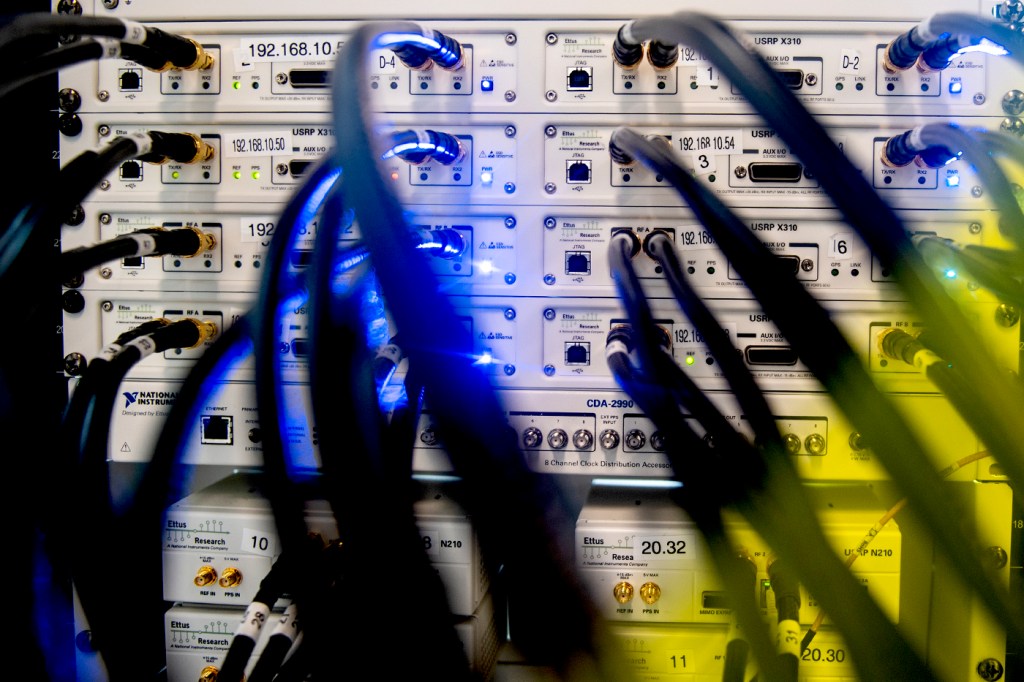Northeastern University to design the wireless networks of the future using world’s most powerful radio frequency emulator

The National Science Foundation and the Defense Advanced Research Projects Agency have selected Northeastern University to run a massive data center that will enable researchers around the country to build and test the next generation of wireless technology and find new ways to use artificial intelligence to shape the smart devices of the future.
The testbed, named Colosseum after the iconic Roman amphitheater, is the world’s most powerful emulator of wireless systems. It can process more information in a single second than is estimated to be held in the entire print collection of the Library of Congress.
Colosseum is capable of creating virtual environments that have hundreds of wireless signals hurtling through them, which will enable researchers to understand how these signals interact, develop artificial intelligence algorithms that allow more devices to share the wireless space, and design ways to protect the system from attackers.
“With Colosseum, you can see how 250 intelligent radios interact with one another across a square kilometer,” says Tommaso Melodia, the William Lincoln Smith Chair Professor of Electrical and Computer Engineering at Northeastern. “You can very simply emulate all of these very complex scenarios. This will help us design and build the wireless systems of tomorrow.”
Colosseum will move from the Applied Physics Lab at Johns Hopkins University to Northeastern’s Innovation Campus in November, where it will join the Platforms for Advanced Wireless Research program, which is co-led by Northeastern and US Ignite. The program, which is supported by the National Science Foundation, provides researchers with facilities to experimentally evaluate wireless networked systems in real-life testing scenarios. The addition of Colosseum will allow researchers to virtually test their ideas before taking them to one of the program’s real-world testing sites.
Colosseum will become part of Northeastern’s Institute for the Wireless Internet of Things, under the leadership of Melodia, associate professors Kaushik Chowdhury and Stefano Basagni of the College of Engineering, and Abhimanyu Gosain, who is the technical director of the Platforms for Advanced Wireless Research program.
Colosseum, which takes up almost 1,000 square feet of space, can emulate, in real time, up to 256 wireless devices, interacting across 65,000 channels. This processing power can be used to create virtual worlds, as though the devices were operating in, say, an open field, a shopping mall, or a desert, and run simulations to see how wireless signals bounce off buildings or interfere with one another as they move through space.
The spectrum of useable wireless frequencies isn’t infinite. It’s getting more crowded every day, as a growing number of devices, such as tablets, thermostats, and even refrigerators, rely on wireless communication. Signals on the same frequency can disrupt and interfere with one another, if they’re in the same area, and it is becoming increasingly difficult to keep this from happening.
Northeastern’s expertise in radio frequency research, combined with the processing power of Colosseum, perfectly position the university to solve this and other challenges facing the future of wireless technologies, says David Luzzi, senior vice provost for research and vice president of Northeastern’s Innovation Campus in Burlington, Massachusetts.
Northeastern already houses a state-of-the-art drone-testing facility, where researchers use an array of antennas and radios to create complicated environments full of wireless signals that could be used to disrupt drones.
“Bringing Colosseum to Northeastern is a testament to the university’s leadership in radio frequency research,” Luzzi says. “This unique-in-the-world combination of facilities will be an asset for radio frequency research by Northeastern, its research and development partners, and users from around the nation. We expect major advances that originate from the work done with these facilities to advance U.S. leadership in radio frequency telecommunications.”
Colosseum, which cost $20 million to build, was originally designed by the Defense Advanced Research Projects Agency for a competition in which teams of researchers around the country used artificial intelligence to collaboratively decide how to share the wireless spectrum in specific scenarios.
Northeastern submitted a proposal to the Defense Advanced Research Projects Agency and the National Science Foundation to take over the management of Colosseum once the competition ends, and received $5 million in funding from the National Science Foundation to support the effort.
“Northeastern University ably demonstrated the technical expertise and organizational support required to manage the transition of the Colosseum from DARPA to NSF, and was selected through a highly competitive review process meeting the expectations from both DARPA and NSF,” says Monisha Ghosh, who is managing the project for the National Science Foundation.
At Northeastern, Colosseum’s capabilities will be expanded to allow researchers to build their own scenarios, enabling them to study and design systems capable of handling the numerous challenges arising in an increasingly wireless world.
“Colosseum was designed to challenge the world to tackle the hardest problems in spectrum-sharing by embracing the intersection of wireless communications and artificial intelligence,” says Paul Tilghman, the program manager at the Defense Advanced Research Projects Agency who spearheaded the competition. “I’m excited that Colosseum will continue to allow this type of impactful research for years to come.”
Colosseum will be made available to the wider community of academic, industry, and government researchers in April 2020.
“We’re going to evolve it over the years, based on the demand from the research community,” Melodia says. “This is a game changer, in terms of the future of how we design complex wireless systems powered by artificial intelligence that interacts with the physical environment.”
For media inquiries, please contact Shannon Nargi at s.nargi@northeastern.edu or 617-373-5718.





